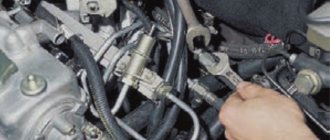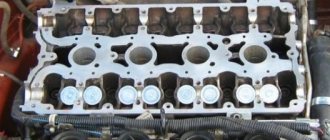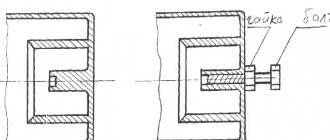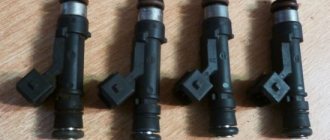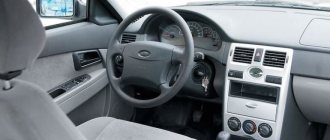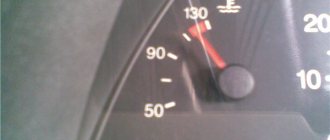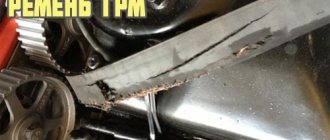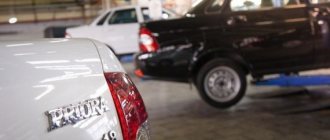Replacing injectors on a Lada Priora car
Before we move on to describing the process of removing the injectors, you need to select everything you need for the job. Here is a list of tools and consumables:
- Phillips screwdriver;
- set of hex keys;
- set of open-end wrenches;
- pliers;
- wrench and set of socket heads;
- flat screwdriver.
Sequence of work
- The block to which the wires of the Priora injectors are connected is manually disconnected and removed.
The block with wires on the Priora fuel rail is removed manually
The mounting fuel rail on the Priora can only be unscrewed with a Phillips screwdriver
The Priora fuel fitting should be unscrewed with only two keys
The O-rings from the Priora ramp should be removed so as not to lose them
The Priora ventilation hose can only be removed after loosening the clamp
It is convenient to loosen the Priora brake hose clamp with pliers
The Priora intake pipeline is held on top by only two nuts
After unscrewing the fasteners, you can simply pull the Priora pipeline towards you
Two 5-point screws on the Priora ramp can only be unscrewed with a hexagon
The Priora fuel rail is removed along with injectors and wires
The injector on the Priora can be unscrewed from the ramp manually
Cleaning on removed injectors
In order to clean the injectors, the first step is to remove them. How to quickly replace them is written in this article.
When the injectors are removed, you can proceed to cleaning them.
Connection diagram!
Since the nozzle opens at a power of 12V and 10W, it is necessary to make wire connections, the circuit of which will include a light bulb. It will thus act as a damper. You can make such a circuit using this diagram:
Detailed connection diagram.
- Next, when everything is connected according to the diagram, we connect power to the injector, but leave the other end unpowered.
- Since cleaning will be done under pressure, take care to ensure that all connections are properly secured. It is best to use hot melt glue.
It will be useful: Cleaning the throttle valve of daewoo nexia and lanos with your own hands. how to clean the throttle valve of Daewoo Nexia and Daewoo Lanos
The pipe to the sprayer is fixed with hot-melt adhesive.
Injector cleaning technology
- First of all, remove the O-ring from the injector.
- We put a pre-prepared rubber tube on its shank.
The entire structure is assembled.
The nozzle is cleaned and the lamp lights up.
In total, you will need about 3 hours to complete such work.
The difference before and after cleaning.
Replacing injectors on a Lada Priora car
Before we move on to describing the process of removing the injectors, you need to select everything you need for the job. Here is a list of tools and consumables:
- Phillips screwdriver;
- set of hex keys;
- set of open-end wrenches;
- pliers;
- wrench and set of socket heads;
- flat screwdriver.
Sequence of work
- The block to which the wires of the Priora injectors are connected is manually disconnected and removed.
The block with wires on the Priora fuel rail is removed manually - Now use a Phillips screwdriver to unscrew the screw holding the pressure plate of the fuel pipe.
The mounting fuel rail on the Priora can only be unscrewed with a Phillips screwdriver - Use a 17 wrench to unscrew the fuel pipe fitting.
In this case, the tip of the tube must be held with a key at “22”, preventing it from turning. Without this, the fuel rail may break. The Priora fuel fitting should be unscrewed with only two keys - The fuel pipe is carefully removed from the ramp, and the sealing rings are removed from it.
The O-rings from the Priora ramp should be removed so as not to lose them - Use a Phillips screwdriver to loosen the clamp on the crankcase ventilation hose.
The hose is then manually disconnected from the cylinder block. The Priora ventilation hose can only be removed after loosening the clamp - The tube with lubricant level indicators is removed.
- There is a hose on the intake manifold that goes to the vacuum brake booster.
The clamp on this hose is loosened with pliers. It is convenient to loosen the Priora brake hose clamp with pliers - Use a socket head to “10” to unscrew a pair of nuts on the fastenings of the intake pipelines.
The Priora intake pipeline is held on top by only two nuts - Then, using a “13” head, unscrew all the bolts on the lower fastening of the pipelines.
- The pipeline, freed from the fasteners, is slightly lifted up and pulled towards itself. Access to the fuel rail is provided. After unscrewing the fasteners, you can simply pull the Priora pipeline towards you
- The ramp is held on the cylinder block by two screws at “5”.
They can only be unscrewed using a hex wrench. Two 5-point screws on the Priora ramp can only be unscrewed with a hexagon - After this, the ramp is removed from the cylinder block along with the injectors and wires.
The Priora fuel rail is removed along with injectors and wires - Old injectors are unscrewed from the ramp and replaced with new ones.
The injector on the Priora can be unscrewed from the ramp manually - After this, the fuel system is reassembled.
Washing with removal of injectors
What you need:
- Set of wrenches;
- O-rings for injectors 16 pcs;
- Carburetor cleaner;
- Syringe;
- Injector plug 1 pc. or mother chips 2 pcs;
- Two-core wire up to 1 m long;
- Intake receiver O-rings;
Injector removal process
- First, we relieve the pressure in the fuel rail; how to do this is written above.
- In order to dismantle the fuel rail, it is necessary to remove the intake manifold.
- We remove the intake manifold corrugation by unscrewing the clamp from the DZ and unscrewing the clamp from the low crankcase ventilation, and remove the chip from the mass air flow sensor.
- Unscrew the dipstick with a screwdriver and pull it up.
- Unscrew the breather clamp, remove the hose and bend it down.
- We remove individual ignition coils except for the 4th cylinder (it does not interfere).
- Unscrew the two nuts securing the intake manifold from above.
- Unscrew the 2 bolts and 3 nuts securing the intake manifold.
- We move the intake manifold towards the radiator and lift it to the top.
- Under the hood we find a fuel line pipe (if the engine has a return line, there will be two pipes, one of them goes to the fuel rail, so you need to connect to it).
- We take two Keys on “17” and unscrew the fitting connection, carefully without damaging the tube.
- You need to unscrew it like this: position the keys like scissors and squeeze them; you must follow the correct direction so that the fitting and nut are unscrewed and not tightened.
- After the fitting connection is unscrewed on the tube, you will see a rubber ring; it must be removed; if it is in poor condition, it is better to replace it.
- Disconnect the injector wiring harness.
- Using a screwdriver, unscrew the bolt securing the fuel rail tube to the cylinder head.
- Unscrew the two hex bolts to “6”.
- Pull the fuel rail towards you; with a little force, the ramp should come off.
Removing injectors from the fuel rail
- We remove the chip from each injector and dismantle the wiring harness.
- Remove the retaining rings from the injectors
- Pull out the nozzles in a circular motion
Preparing to wash the injectors
In order to wash the removed injectors, it is necessary to prepare a washing device. The injectors are flushed under pressure. To do this, we assemble the injector power supply circuit. The injector receives power from 9 to 12 V. The power source for opening the injector can be a crown battery or a car battery. We will use a rechargeable battery.
So, let's start assembling a device for washing injectors on a Lada car
For convenience, it is better to carry out the procedure together.
- You need to prepare a syringe. Pull the piston out of it; the syringe cylinder should fit tightly onto the nozzle with the ring. You can also use a hose of a suitable diameter instead of a syringe and tighten it with a clamp. We will use a hose.
- Next, we twist the wires with the injector plug or with the “mother” terminals.
- We connect the nozzle to the power source, observing the polarity. "+" and "-"
- The injector should click, which means the injector is opening.
- We hold the nozzle and spray carburetor cleaner into the hose and hold it, creating pressure in the hose between the nozzle and the cleaner bottle.
- Then you need to open the injector by connecting the wires to the battery
- The injector will spray carburetor cleaner and clear itself.
- You can complete the procedure as soon as a uniform spray of fuel begins to emerge from the injector.
- Next, you should do the same procedure with all the injectors.
- Assembly should be carried out in the reverse order of disassembly.
For easier installation of the fuel rail with injectors into the cylinder head, it is recommended to lubricate the O-rings with engine oil.
Now you know in what ways and how you can wash the injectors. We hope our article helped you and you chose a method of washing injectors that is convenient for you.
How to check for faults
The car owner can independently check the performance of the injectors on his car. The procedure is quite simple and does not require special training or expensive equipment. In garage conditions, diagnostics can be performed with a set of open-end wrenches, screwdrivers and a tester with a resistance measurement mode.
Reasons indicating problems
Diagnostics must be performed not after any period of operation or mileage has expired, but in the presence of external manifestations of injector failures. In cases where other vehicle systems are operating normally, the following indicators indicate problems with the injection solenoid valves:
- at idle there is instability in engine speed;
- starting the engine is difficult - the engine may stall;
- when overclocking it is impossible to achieve the same dynamics;
- The amount of fuel consumed has noticeably increased.
Diagnostic procedure
- Open the hood.
- Unclip the plastic clips that secure the valve's power cable. Remove the connector.
- Switch the tester to resistance measurement mode and take measurements of the windings of each of the injectors in turn. That is, you need to apply one contact of the tester to each of the five terminals, and the second one to the fifth wire for power.
- Optimal resistance values in all cases should be in the range of 11–15 ohms. If at least one pin shows deviations, it will be necessary to change the nozzle.
Cleaning procedure
Cleaning injectors can provide the car owner with the following benefits:
restoring the original functionality of the device;
reduction of fuel consumption;
optimization of motor operation.
That is, in case of contamination (use of low-quality fuel), it is possible to flush and clean the valves in order to restore them to functionality.
Open the hood and make sure all vehicle systems are working properly
Several cleaning methods
Experienced drivers know that there are several ways to clean injectors on a Lada Priora. Moreover, each of them has both its pros and cons.
The first option is to use a detergent additive - the liquid is added to gasoline and, after entering the gas tank, it enters the injectors. Usually one bottle of the additive (0.5 l) is enough for a whole tank of fuel. In this case, absolutely all parts of the fuel system are washed. However, the disadvantage of this method is the lack of drainage of dirt - it will remain in the system.
The second option involves using a solvent. It is considered the most effective, since flushing is carried out while the engine is running. However, it is necessary to replace the solvent immediately after using it, as they may stop functioning.
Ultrasonic cleaning of injectors can be considered the most modern method. However, the average car owner cannot always afford to buy this type of equipment.
The Lada Priora car owner can clean and replace faulty injectors on his own - the main thing is to carefully monitor the progress of the work. The solenoid valve on the Priora is considered a fairly reliable element of the fuel system, so you will rarely have to perform any type of work with it.
Carburetor cars are slowly but surely becoming a thing of history. Float chambers and diffusers have been replaced by injectors and distributed fuel injection, the quality of which is controlled by the car’s on-board computer. On the one hand, injectors have made life much easier for motorists. On the other hand, even these reliable devices periodically fail. Fortunately, the driver can replace them with his own hands. The main thing is to know how it's done.
Replacing injectors on a 16-valve Lada Priora engine
As mentioned above, symptoms of injector malfunction include unstable engine operation, starting problems and increased gas mileage. To change the nozzle to a new element, you will have to spend a lot of time, since the replacement procedure is quite complicated.
As a working tool, it is recommended to immediately prepare:
- set of heads;
- set of open-end wrenches;
- Phillips-blade screwdriver.
After the car has stood for some time and cooled down, you can start working:
- The plastic retainer of the harness must be pressed to the side with your finger to pull the bundle of wires out of the injector.
- After which you will need to relieve the pressure in the car’s fuel system. The average pressure is approximately 380 kPa, that is, if work is carried out without bleeding, you can get injured due to sudden fuel emissions. To do this, you will need to open the rear door of the car and remove the seat from the back row.
- There is a carpet under the seat, and under it there is a hatch to the gas tank.
- Using a Phillips screwdriver, unscrew the two screws that secure the hatch cover to the panel and remove the cover.
- From the fuel pump, which is located in the gas tank, you need to disconnect the power wire - the connector can be pulled out without difficulty.
- After this, you need to start the car and wait until the engine stalls due to lack of gasoline.
- Next, you need to run the starter for at least three seconds so that the pressure in the system equalizes.
- Disconnect the cable from the negative terminal on the battery.
- After which the procedure for removing the injectors is possible without risk. To begin, use a screwdriver to unscrew the decorative box on the engine.
- Next, remove the screws securing the air filter box from the car body - it will prevent free access to the engine, so it is better to remove it immediately.
- The wire connected to the throttle valve is disconnected from the intake manifold.
- Next, you will need to disconnect all the lines that connect directly to the frame connectors. It will be necessary to prepare to remove the fuel frame - to do this, use a 10mm wrench to unscrew the bolts that secure the frame to the body.
- Using a screwdriver, loosen the clamps on the ventilation and vacuum hoses and disconnect the hoses from the cylinder block.
- The intake manifold is bolted to the cylinder head with three nuts - you will need to unscrew them to remove the intake manifold.
- After which it will be possible to disconnect the injector harness.
- The fitting through which fuel is supplied is disconnected from the engine compartment.
- After this, you can remove the fuel pipe from the frame, and then dismantle the fuel frame along with the injectors that are located on it.
- The injectors can be pryed off with a screwdriver - the fixing element is easily removed so that you can get to the valve itself.
Video: removal procedure
Thus, dismantling the injectors takes quite a lot of time, since you have to disassemble almost the entire engine compartment of the car. Installation of new injectors is carried out in the reverse order with the obligatory replacement of all rubber seals.
How to remove and clean injectors on a VAZ 2110
There are a huge number of gas stations in our country, but not all of them have fuel quality that meets the standards and needs of the cars themselves. Various contaminants and impurities in gasoline lead to disruption of the quality and efficiency of the engine and its elements. Such as injectors. You can replace them if necessary or clean them yourself.
Symptoms of a problem
With proper care, the injectors on the VAZ 2110 can last quite a long time. But when the first signs of malfunction appear, it is recommended to immediately clean the elements. What are the symptoms?
- The engine starts with certain difficulties;
- Fuel consumption increases;
- Power and thrust drop;
- In winter, the car sometimes jerks;
- The engine starts to stall, etc.
If you notice at least one of the symptoms, be sure to check the injectors and decide whether to clean or replace.
Cleaning methods
There are three main ways that will allow you to clean your injectors. Decide for yourself which one to use.
| Way | Peculiarities |
| Automotive chemistry | Quite effective, but financially expensive. Plus, working with chemicals is risky because it is very dangerous to your health. Cleaning is carried out only in full compliance with safety regulations |
| Service station services | Car services will now do everything for your money. But you'll have to pay a lot. Don’t forget that finding a really good, responsible and inexpensive service station is something out of the realm of fantasy. Therefore, either questionable quality of work, or impressive money for effective cleaning |
| Do-it-yourself cleaning | The most economically profitable way to save money and complete the task efficiently. You should choose this option only if you have an idea about the design of the motor, the location and functions of the injectors |
Do not carry out cleaning yourself if you have never climbed into the engine compartment yourself to replace or repair engine components. Trust trusted specialists, do not take risks.
Dismantling
Before replacing or cleaning the injectors, they will need to be removed from the fuel rail. To achieve this, the following activities are carried out:
- Make sure the engine has cooled down properly. It is not safe to work on a hot engine;
- Disconnect the power wires from the fuel pump to de-energize the device;
- Try to reduce the pressure in the engine power system as much as possible. To do this, the engine starts, and then you need to wait until it stalls at idle speed;
- Repeat this procedure several times until the car simply stops responding to turns of the ignition key;
- That's it, now our goal is the fuel rail. To remove it, you must first remove the terminals from the battery, turn off the power to the ramp itself, disconnect the fuel supply hoses, and also disconnect all electrical appliances going to it. These are pressure, idle, throttle position sensors;
- If you have an 8-valve engine, then you do not need to remove the receiver. This step is relevant for engines with 16 valves;
- Experts do not recommend removing the intake manifold without dismantling the throttle valve and the hose going to it. It is better to unscrew and disconnect everything at once, which will allow you to continue working more conveniently;
- Cover the exhaust manifold openings with something to protect them from foreign objects;
- Using a hex wrench, you can unscrew a couple of bolts and remove the fuel rail along with the injectors;
- Make sure that there are no distortions when removing the ramp, otherwise problems may arise with the dismantling processes;
- We remove the injectors. To do this, remove the mounting brackets that hold the electrical connector. You also need to remove the bracket that holds the injector in its seat.
Injectors installed on Priora
The Lada Priora car is equipped with imported injectors manufactured by the German company BOSCH. These devices are highly reliable. Their service life can reach 160 thousand kilometers. However, car service specialists strongly recommend changing injectors every 120 thousand km.
Almost all Prioras are equipped with German injectors from BOSCH
Injectors for 8 and 16 valve engines
You should know that the injectors of the 8-valve Priora engine are no different in appearance from the injectors of the 16-valve engine. These are all the same devices from BOSCH, consisting of a housing, a coil, a diffuser and a fuel grid. When choosing injectors for a Priora, you need to think not about the number of valves in the engine, but about its volume. Because the markings of injectors for 1.5 liter engines are different from the markings of injectors for 1.6 liter engines. In the first case, the BOSCH injector should be marked 0-280-158-110, in the second - 0-280-158-502. You can clarify the markings in the car’s operating instructions, at the end of which there is a summary table with digital designations of all BOSCH injectors depending on engine size.
Table of applicability of injectors for VAZ cars
INJECTOR SET BOSCH 017 FOR LADA KALINA, PRIORA, CHEVROLET NIVA
Statistical flow at 3 bar, average n-Heptane - 105.7 g/min
Resistance - 12 Ohm
Fuel preparation - gasoline injection
The price is per set!
Catalog number: 0 280 158 017
Manufacturer: BOSCH
Specifications:
Statistical flow at 3 bar, average n-Heptane - 105.7 g/min
Resistance - 12 Ohm
Fuel preparation - gasoline injection
The price is per set!
Catalog number: 0 280 158 017
Manufacturer: BOSCH
Payment to Sberbank VISA card
The most convenient and profitable payment method for you. Payment can be made through the Sberbank Online system, through a payment terminal (Sberbank ATM), provided that you have a card from this bank. If you are not a client of this bank and you do not have a card, then you can top up your balance at any bank branch through an operator; they will accept cash payment and top up your balance. Commission from 0 to 1%
Cash on delivery (payment upon receipt)
Payment for the order will be made at the post office upon receipt of the goods. For cash on delivery services, Russian Post takes an additional commission - approximately 4% of the cost of the order (parcel) upon receipt.
The postal commission based on the amount of “Cash on Delivery” for your parcel is described below, i.e. In addition to the delivery cost, the post office will also charge you a commission for .
Postal commission for cash on delivery service:
· up to 1,000 rub. inclusive - 80 rub. + 5% of the amount
· over 1,000 to 5,000 rubles. inclusive - 90 rub. + 4%
· over 5,000 rub. up to 20,000 rub. inclusive -190 rub. + 2%
· over 20,000 rub. up to 500,000 rub. inclusive - 290 rub. + 1.5%
Attention! Advance payment for delivery 100% (via Sberbank payment). This is included in our Cash on Delivery terms and conditions.
Check with the manager for additional information.
Yandex money. This payment method involves issuing an invoice in the Yandex.Money system. You can pay from your Yandex.Money wallet
ATTENTION! There are restrictions on the payment amount: anonymous wallet 15,000 rubles, registered wallet 60,000 rubles, identified wallet 250,000 rubles. After payment you will receive an electronic cash receipt
QIWI Wallet. This payment method involves issuing an invoice in the QIWI system. You will be able to pay from your QIWI wallet
ATTENTION! There are restrictions on the payment amount: RUB 250,000. After payment you will receive an electronic cash receipt
Attention! Regardless of which delivery method you choose, check the integrity of the goods and packaging upon receipt of the cargo (parcel)
Delivery by Russian Post (payment by Sberbank)
Russian Post (payment upon receipt)
Post EMS (courier)
EMS company
is a division of Russian Post, part of the global EMS (Express Mail Service) system. Express delivery worldwide.
Purification process
Cleaning the nozzles itself should be done on a clean surface - for this you can cover the working surface with a piece of cloth.
Prepare a hose and a can for cleaning the carburetor. To flush, secure a plastic hose clamp at the inlet of the nozzle (make sure the length is at least 20 cm). The nozzle will need to be turned on, and the end of the hose itself will need to be lowered into the liquid that is used to flush the carburetor. Cleaning can be carried out by any of the proposed ones - RunWay, Liqui Moly or Hi-Gear.
But there is no need to add cleaning additives advertised on the market to the fuel: it very often happens that they harm the engine. The acidified dirt itself after such cleaning can create a blockage that will prevent normal access to the fuel-air mixture. Otherwise, fuel access may be blocked.
Cleaning is complete. Now do the installation in reverse order.
I decided to start cleaning the injectors on my car. The car ran no less, but so to speak, I decided to do preventive maintenance on cleaning the injectors on my car. The whole purchase began with Wynn's injector flushing fluid 1
Wynn's flushing liquids are used for washing injector nozzles without dismantling, cleaning the cylinder-piston group (partial removal of carbon deposits from the cylinder walls and sealing rings) as well as the exhaust system without harming the catalytic converter.
And since I did not want to remove the injectors from the engine, this was the flushing fluid that suited me as a flush. I once found information on the Internet about cleaning injectors in this way and decided to do the same operation without removing the injectors on my car. In general, for this I needed to buy some things that were necessary for this DIY flushing device. For this I needed:
For this I needed. 1. Flushing liquid 1l. 2. Fuel filter. 3. Clamps 2 pcs. 4. Two nipples. 5. Hose 12mm -1 meter. 6. Two liter bottle. 7. Drill 13 8. Compression pump
Flushing liquid 1l
Self-cleaning of VAZ 2110 injectors. How to wash the injectors with your own hands
Author: ides · Published 07/12/2016 · Updated 07/12/2016
Cleaning injectors
refers to those types of work that need to be done only in case of emergency, that is, according to the principle “don’t touch it while it’s quiet.” This is not surprising, given the fact that the ramp in which the injectors are located and, in principle, the injectors themselves can be called the heart of a car engine. Therefore, it is recommended to clean injectors only as a last resort, for example, when problems occur with starting the engine, increased fuel consumption, tripping or a sharp drop in power.
There are plenty of various additives on the automotive chemicals market that are added to fuel to clean the injector, but they are not always able to cope with the task assigned to them or do not perform it very well. Often, cleaning additives in fuel can cause irreparable harm to the engine, due to the fact that acidified dirt and other deposits can create a blockage that prevents the normal passage of the fuel-air mixture or completely block the access of fuel. In this article I will talk about how to clean injectors with your own hands using the example of a VAZ 2110.
Relevant: Do-it-yourself adjustment of VAZ 2101 valves
Cleaning VAZ 2110 injectors - removing the ramp
Attention is important! In order to remove the ramp on a VAZ 2110, you must wait until the engine cools down.
1. First of all, you need to turn off the power to the fuel pump; to do this, disconnect the wires from it.
2. After this, start the engine and let it run until it stalls. This should be done until the engine stops starting; in other words, your task is to remove pressure from the fuel supply system.
3. Now you can remove the ramp.
4. First of all, de-energize the ramp; to do this, turn off its power - the general wiring is located on the passenger compartment side.
5. Unscrew the fuel hoses, as well as all electrical components connected to the fuel rail: idle air control (IAC), throttle position sensor, pressure regulator.
6. Use a hexagon to unscrew the two bolts that secure the fuel rail.
7. Now you can actually remove the fuel rail itself. This is done in the upward direction, but without available tools this is sometimes quite difficult to do, since the fuel rail fits quite tightly. Remove the ramp strictly parallel to the ground, as any misalignment will only complicate your task.
What injectors are installed on Priora cars?
Injectors are an indispensable element in the operation of any power unit with continuous injection. Structurally, they are electromagnetic valves, which, when opening, ensure the supply (injection) of fuel in the required volume into the engine cylinders. At the same time, the main purpose of the part is to save fuel, so the valve opens at regular intervals, depending on the driving mode.
Have a red body
On "Priors" equipped with an injection type engine, imported injectors are installed. Products manufactured by Bosch and Siemens are characterized by a high degree of reliability and wear resistance. Their service life is determined by a mileage of 100–150 thousand kilometers, after which it is recommended to change them.
Usually available in black
Differences between injectors for 8 and 16 valve engines
Various modifications of Priora are equipped with parts of the same model. There are no differences for 8 and 16 valve power units. The only thing is that you should be careful when selecting injectors for engines of different sizes: for example, for a 1.5 engine, spare parts will differ in markings, color and thickness from those for a 1.6.
It is recommended to choose materials from the same manufacturer that were equipped with the car at the factory.
5.18.11. Checking and replacing injectors
Signs of injector malfunction may include: – difficult engine starting; – unstable engine operation; – the engine stalls at idle; – reduced crankshaft rotation speed at idle; – the engine does not develop full power, insufficient engine response; – failures in engine operation when the vehicle is moving; – increased fuel consumption; – increased content of CH in the exhaust gases. You will need: a 5-point hex key, a flat-blade screwdriver, a 17-point key (two), an autotester.
| 1. Disconnect the connecting block of the injector wiring harness and the engine harness by pressing the lock. | 2. Perform an initial check of the injector windings. To do this, connect the ohmmeter to the contacts of the pads one by one. |
| Note There are five contacts in the block: four for supplying a control signal to the injectors and one common “+12 V” (a crimson wire with a black stripe is connected to it). |
3. In turn, connect the four control contacts to the common contact and measure the resistance in each case. It should be 11–15 ohms. If in one or more measurements the resistance value differs from the specified value, the tested injectors or their wiring harness may be faulty.
4. For a more accurate check and replacement of injectors, remove the fuel rail from the car (see “Removing and installing the fuel rail”).
| 5. Use a screwdriver to pry off the spring retainer of the injector... | 6. ...remove the clamp... |
| 7. ...and remove the injector from the fuel rail. Remove the remaining injectors in the same way. | 8. To identify a faulty injector, connect an ohmmeter to the injector contacts. It should show a resistance of 11-15 ohms. If the winding resistance is not normal, replace the faulty injector, as it cannot be repaired. |
| Note Check the injector for the shape of the sprayed fuel spray and for leaks at specialized service stations, since such a check directly on the car is very fire hazardous. |
| Warning The injectors of the VAZ-21126-00 engine of the VAZ-2170 Lada Priora have an original design and are not interchangeable with the injectors of VAZ injection engines of other models. Buy new injectors with exactly the same markings. |
| 9. Whenever removing injectors, be sure to replace the O-rings on all injectors on the ramp side. Using a screwdriver, carefully pry the edge of the ring... | 10. ...remove the sealing ring from the injector... |
11. ...and similarly remove the ring from the sprayer side. 12. If you are installing old injectors, carefully wash their nozzles with solvent or carburetor cleaner.
| Warning Install new sealing rings carefully, without using any tools, after lubricating them with engine oil. |
| Note The sealing rings on the injectors are identical to other rings installed on early VAZ models with fuel injection systems and are interchangeable with them. |
| 13. Before installing the injectors, lubricate the O-rings with engine oil or WD-40. | 14. Install the injectors in the reverse order of removal, securing them to the ramp with clamps, after tightening them a little. |
15. Having installed the fuel rail, connected the fuel line and connected the wiring harness block, secure the minus terminal on the battery, turn the ignition key 3-4 times to position “I” (ignition) at intervals of 2-3 s between turns on and check for leaks pipe connections and injector seals. 16. Install all removed parts in the reverse order of removal.
How to remove injectors on a Priora with air conditioning
Removing and installing Lada Priora injectors
- Signs of injector failure may include:
- – difficult engine starting;
- – unstable engine operation;
- – the engine stalls at idle;
- – reduced crankshaft speed of the VAZ 2171 at idle;
- – the engine does not develop full power, insufficient engine response;
- – failures in engine operation when driving;
- – increased fuel consumption;
- – increased content of CH in the exhaust gases.
You will need: a 5-point hex key, a flat-blade screwdriver, a 17-point key (two), an autotester.
1. Disconnect the connecting block of the injector wiring harness and the engine harness by pressing the lock.
2. Carry out an initial check of the injector windings of the VAZ 2172. To do this, connect an ohmmeter to the contacts of the pads one by one.
The block has five contacts: four for supplying a control signal to the injectors and one common “+12 V” (a crimson wire with a black stripe is connected to it).
3. In turn, connect the four control contacts to the common contact and measure the resistance in each case. It should be 11–15 ohms. If during one or more measurements the resistance value differs from the specified one, the Lada Priora injectors being tested or their wiring harness may be faulty.
4. For a more accurate check and replacement of injectors, remove the fuel rail from the Priora fret (see “Removing and installing the fuel rail”).
5. Use a screwdriver to pry off the spring retainer of the injector...
Removing injectors on Priora (Lada 2170, VAZ 2112)
Thank you so much for watching my videos, tell your friends, leave comments and subscribe...
Causes of injector contamination
When a mixture of air and fuel burns, a tar deposit is formed. It is deposited not only in the combustion chamber of the engine, but also on the surface of the nozzles. This leads to their gradual contamination. The shape and diameter of the hole in the nozzle body gradually decreases. The result is insufficient supply, a change in the spraying process. The mixture turns out to be heterogeneous. Instead of the injector delivering a mist of fuel into the engine, it sprays small streams of fuel.
The structure of the mixture changes, and an excessive amount of air or fuel appears in it. Engine performance decreases, the on-board computer tries to adapt the car to new conditions, supplying even more gasoline, which cannot burn completely.
Gasoline injectors work even worse in winter, when fuel evaporates more slowly. This leads to more intense pollution.
Signs of clogged injector nozzles
If the problem still cannot be avoided, there are several signs by which you can determine that it is necessary to clean the injectors much earlier:
- Loss of engine power (a small amount of fuel-air mixture is supplied to the combustion chamber);
- Increased fuel consumption;
- Periodic pops (detonation) while the engine is running;
- Exhaust of black smoke from a car muffler;
- Unstable engine operation (engine speed jumps).
It is worth noting that if any of the above symptoms appear, you should not immediately try to clean the injector. The fact is that the cause of the malfunction may be other problems in the system, for example, a clogged particulate filter or a breakdown of another part. In any case, first you need to conduct a thorough diagnosis of the engine, and only then, after making sure that the injectors are clogged, proceed to flushing the injector.
Cleaning Priora injectors
There are two options for washing injectors: with and without removing them from the car. The removed injectors are washed on special stands using ultrasound, under the influence of which even the oldest contaminants disappear. Ordinary drivers do not have such stands, so below we will consider a more popular option for washing injectors without removing them from the Priora. Here's what you'll need for this:
- liter of special flushing fluid;
- two automobile nipples;
- automobile fuel filter;
- a pair of metal clamps;
- a meter piece of rubber hose with a diameter of 12 mm;
- drill with 13 mm drill bit;
- electric pump;
- two liter plastic bottle.
Flushing sequence
- The bottom and cap are drilled into the plastic bottle. This is done with a “13” drill. Automotive nipples are inserted into the holes.
- The spool is unscrewed from the nipple inserted into the plug. This must be done so that the flushing liquid passes freely into the nozzles.
- Now a rubber hose is put on the nipple inserted into the plug and secured with a metal clamp. The second end of the hose is put on the fuel filter and secured with a second clamp. A piece of rope is screwed to the bottle with tape (so that the bottle can be hung on the hood).
- The car starts. You must wait until the engine warms up to 90 degrees. After warming up the car turns off. The fuel hoses are removed from the fuel pump, the car starts again and runs until it stalls. All this is done in order to completely relieve pressure in the fuel line.
- Now you need to find the fuel hose with a green button on the clamp, connected to the fuel line. To remove it, just press the green button and pull it towards you.
- The hose is put on the fuel filter (the clamp with the green button should make a characteristic click).
- The washing liquid is poured into a plastic bottle.
- An electric pump hose is connected to a nipple inserted into the bottom of the bottle, after which the bottle is suspended on the open hood of the car.
- Using a pump, a pressure of 3 atmospheres is created in the bottle (as the liquid flows out of the bottle, the pump will have to be turned on several more times to maintain this pressure).
- After the required pressure has been created in the bottle, the car starts at idle and runs for 15 minutes.
- After this time, the engine is turned off and cools down for 10 minutes.
- If there is still liquid left in the bottle, the engine starts again and runs until it stalls.
- After this, the flushing system is removed from the car, and the fuel hose is installed in its original place. Injector flushing is complete.
About the design of Priora injectors
We adjust valves on a VAZ-2112 16 valves with our own hands
It was these components that gave the common name to the type of car with an ECM. None of the drivers wants to pronounce the full name. They say simply - an injector. So what is a nozzle (injector)? This is a device that allows you to inject fuel, under pressure, directly into the working chamber of the cylinder in strictly metered portions.
The principle of operation of Priora injectors is based on the electromagnetic effect. When the circuit is closed, the coil retracts the core, which opens the channel for supplying fuel accumulated in the fuel frame under pressure. The opening signal comes from the electronic control unit (ECU). The nozzle consists of the following parts:
- Frame.
- Coil.
- Fuel cleaning mesh.
- Nozzle with holes (diffuser).
Main problems of injectors
Malfunctions of these important components of the Lada Priora car can be divided into two categories:
- Electrical part.
- Mechanical component.
The first option includes damage to the coil or connector. A break or interturn short circuit may occur in the coil. One or both contacts in the connector may break. Over time or from an impact they break off. In any case, such a nozzle requires replacement.
Mechanical malfunctions of Priora injectors include various changes in the diameter of the fuel supply channel. Most often with Priora, this is contamination caused by the settling of foreign particles on the walls of the channel and in the diffuser. Or corrosion (increase) in diameter under the influence of additives. Although this happens extremely rarely at Priora. With an increase, there are no options other than replacement. But if they become dirty, you can wash the nozzles. About replacement and flushing, about identifying a breakdown, further.
Important! Contamination of the contact area of the shutter needle can also cause incomplete closure and fuel leakage
Symptoms of malfunction and diagnosis of injectors
"Priora" begins to "triple". The engine shakes at idle. When driving, loss of power and failure to gain speed. The “Check Anger” lamp gives a signal. This means that one of the cylinders is not working as expected. First of all, you need to do computer diagnostics and count the errors. The ECU detects faults in the electrical part immediately. Otherwise, it gives at least an accurate orientation to the inoperative cylinder. And then all that remains is to determine what failed:
- Candle with coil.
- Compression in the cylinder.
- Nozzle.
Knowing which of the “boilers” is not working makes it easier to act. The first thing to do is measure the compression. On a cold engine. If it is within the normal range, move on to candles. First, swap the coils on the Priora engine. If the leaks are again in the same cylinder, swap the spark plugs. Here you go. Nothing has changed. So this is an injector.
Attention! The nature of the malfunction can be indicated by the spark plug! If it is clean, then fuel is not flowing. But blackening and deposits on the electrodes indicate that the nozzle “does not hold” fuel and “floods” the spark plug.
Injector works perfectly
Perfect combustion of fuel can only be achieved if the injector is fully operational. Translated from English, it is called a motor pump.
To understand how to properly clean, you need to know the operating principles of the mechanism itself. This part is based on one or two channels. The first will receive the sprayed liquid, the second will receive the same steam or gas, which will spray the first liquid. The torch will burn continuously and evenly if the nozzle is of high quality and clean. In gasoline engines like the Lada Priora, an electromagnetic injector is usually used. It is a simple device that operates using an electronic control unit - at the right time it is required to supply voltage to the valve excitation winding. Thus, an electromagnetic field will be created: it will retract the valve with the needle and release the nozzle. The fuel will inject, the voltage will disappear and the needle will return to the seat.
How to dismantle injectors for Priora
The Lada Priora car model is a popular solution in the domestic automobile industry. In order to clean the injectors, you will need the following set of tools:
All work must be carried out at least four hours after the end of pressure reduction operations, otherwise it can be simply dangerous.
Cleaning begins with dismantling - otherwise you simply won’t be able to get to them. To get to the Lada Priora injectors, you need to do it according to the following scenario.
- First you need to press out the fixing element, after which all that remains is to disconnect the connecting block at the wiring harness and the block of the engine wiring harness.
- Carry out an initial check of the injector windings.
- Now connect the ohmmeter to the contacts of the pads one by one.
- Connect all four control contacts in turn to the common contact (resistance must be measured each time - it should be from 11 to 14 Ohms). Other indicators indicate a faulty fuel injector.
- Engage neutral gear.
- Secure the vehicle with the parking brake system.
- Remove the cushion from the rear seat.
- Pry and lift the carpet over the hatch.
- Unscrew the two screws securing the hatch cover above the fuel pump.
- Remove the hatch cover.
- Unscrew the clamp of the wiring harness block at the fuel pump.
- Disconnect the wiring harness connector from the fuel pump.
- Turn on the engine. Now you need to wait for it to stop (thus, the fuel from the fuel frame itself will be completely exhausted).
- You will need to run the starter for three seconds - this will equalize the pressure in the fuel lines.
- Disconnect the negative cable from the battery.
- Remove the decorative casing.
- Remove the air filter.
- Remove the pipes leading upward from the air filter.
- Disconnect the wiring harnesses at the injectors (the common harness is located near the windshield under the thermostat pipes).
- Disconnect the idle air control harnesses.
- Disconnect the sensor harness at the throttle position.
- We disconnect the white vacuum hose from the fuel pressure regulator itself - this must be done carefully, because coolant may spill.
- Unscrew the fuel supply pipes using a 17 wrench into the ramp (also be careful, because gasoline may spill).
- Remove the throttle cable.
- Unscrew the fastening bolt from the plate that pressed the fuel hoses.
- Use a 8mm hex to unscrew the plate mounting bolts.
- Now all that remains is to very carefully lift the ramp structure with the nozzles up.
The best injectors for VAZ 2110-12
Injector malfunctions or how to check the injectors: 1. Coking of the outlet holes.
Symptom: increased gas consumption, poor engine starting, deterioration in vehicle dynamics. Otherwise, the engine behaves normally, idle speed is stable and starts normally at positive temperatures; at negative temperatures, starting is difficult.
2. Leaky closing of the nozzle valve.
- Symptom: increased fuel consumption, poor engine starting, tripping or detonation at idle.
- Diagnostics: measure CO (on a normally running engine without a catalyst, CO should not exceed 1% in idle mode. One leaking injector increases CO by approximately 1.0-1.5%).
3. Valve stuck.
- The sign is engine tripping.
- Diagnostics: disconnecting and then connecting the injector electrical connector with the engine running. If the injector is faulty, then there will be no engine response; if the injector is working, then there will be a temporary drop in speed.
4. Unstable valve hanging.
- Symptom: floating idle (a sharp drop in idle speed followed by an increase to 1000 - 1400 revolutions or a complete stop of the engine).
- Diagnostics: as in point No. 3. If one injector hangs unstable, it is guaranteed to be diagnosed as a shutdown. If two or more, then only by replacement.
Example, injectors with a mileage of 198 thousand km. At 40 thousand km, ultrasonic washing was done, and at 170 thousand km. Lavr decarbonizer was poured.
About VAZ injectors of the tenth family: “Dozens” were equipped with Bosch and Siemens injectors. Standard injectors from the factory are mainly Bosch injectors 0 280 158 996 (or 996e).
Interchangeability of VAZ injectors: Injectors come in not only different sizes, but also different in performance. To understand which injectors are suitable for your car, just use the table:
Addition to the table: BOSCH 0 280 150 996 nozzles are no longer produced; their analogue is BOSCH 0 280 158 110 (capacity 170 cc/min). There are some differences, for example, the rubber sealing ring on the 110th is a couple of millimeters higher than on the 996th, and the “tail” (from which it splashes) is longer. But there should not be any difficulties when installing the injectors.
